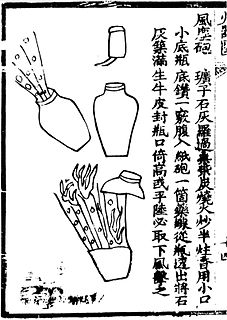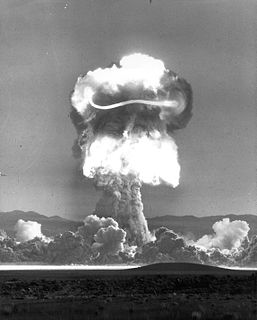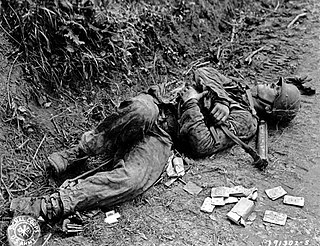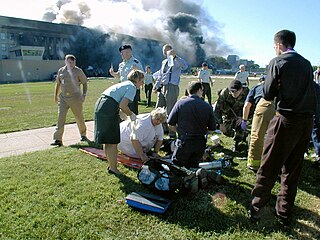Related Research Articles

Civil defense or civil protection is an effort to protect the citizens of a state from natural disasters. It uses the principles of emergency operations: prevention, mitigation, preparation, response, or emergency evacuation and recovery. Programs of this sort were initially discussed at least as early as the 1920s and were implemented in some countries during the 1930s as the threat of war and aerial bombardment grew. It became widespread after the threat of nuclear weapons was realized.

The TomahawkLand Attack Missile (TLAM) is a long-range, all-weather, jet-powered, subsonic cruise missile that is primarily used by the United States Navy and Royal Navy in ship- and submarine-based land-attack operations.

Nuclear warfare, also known as atomic warfare and thermonuclear warfare, is a theoretical military conflict or prepared political strategy that deploys nuclear weaponry. Nuclear weapons are weapons of mass destruction; in contrast to conventional warfare, nuclear warfare can produce destruction in a much shorter time and can have a long-lasting radiological result. A major nuclear exchange would likely have long-term effects, primarily from the fallout released, and could also lead to a "nuclear winter" that could last for decades, centuries, or even millennia after the initial attack. Some analysts dismiss the nuclear winter hypothesis, and calculate that even with nuclear weapon stockpiles at Cold War highs, although there would be billions of casualties, billions more people living in rural areas would nevertheless survive. However, others have argued that secondary effects of a nuclear holocaust, such as nuclear famine and societal collapse, would cause almost every human on Earth to starve to death.
A neutron bomb, officially defined as a type of enhanced radiation weapon (ERW), is a low-yield thermonuclear weapon designed to maximize lethal neutron radiation in the immediate vicinity of the blast while minimizing the physical power of the blast itself. The neutron release generated by a nuclear fusion reaction is intentionally allowed to escape the weapon, rather than being absorbed by its other components. The neutron burst, which is used as the primary destructive action of the warhead, is able to penetrate enemy armor more effectively than a conventional warhead, thus making it more lethal as a tactical weapon.

A bomb is an explosive weapon that uses the exothermic reaction of an explosive material to provide an extremely sudden and violent release of energy. Detonations inflict damage principally through ground- and atmosphere-transmitted mechanical stress, the impact and penetration of pressure-driven projectiles, pressure damage, and explosion-generated effects. Bombs have been utilized since the 11th century starting in East Asia.

"Duck and cover" is a method of personal protection against the effects of a nuclear explosion. Ducking and covering is useful in offering a degree of protection to personnel located outside the radius of the nuclear fireball but still within sufficient range of the nuclear explosion that standing upright and uncovered is likely to cause serious injury or death. In the most literal interpretation, the focus of the maneuver is primarily on protective actions one can take during the first few crucial seconds-to-minutes after the event, while the film of the same name and a full encompassing of the advice also cater to providing protection up to weeks after the event.

Operation Plumbbob was a series of nuclear tests conducted between May 28 and October 7, 1957, at the Nevada Test Site, following Project 57, and preceding Project 58/58A.

The AGM-86 ALCM is an American subsonic air-launched cruise missile (ALCM) built by Boeing and operated by the United States Air Force. This missile was developed to increase the effectiveness and survivability of the Boeing B-52H Stratofortress strategic bomber. The missile dilutes an enemy's forces and complicates air defense of its territory.

A casualty, as a term in military usage, is a person in military service, combatant or non-combatant, who becomes unavailable for duty due to any of several circumstances, including death, injury, illness, capture or desertion.

Chernobyl liquidators were the civil and military personnel who were called upon to deal with the consequences of the 1986 Chernobyl nuclear disaster in the Soviet Union on the site of the event. The liquidators are widely credited with limiting both the immediate and long-term damage from the disaster.

United States civil defense refers to the use of civil defense in the history of the United States, which is the organized non-military effort to prepare Americans for military attack. Late in the 20th century, the term and practice of civil defense fell into disuse. Emergency management and homeland security replaced them.

Beginning in the mid-1930s, Japan conducted numerous attempts to acquire and develop weapons of mass destruction. The 1943 Battle of Changde saw Japanese use of both bioweapons and chemical weapons, and the Japanese conducted a serious, though futile, nuclear weapon program.
Philip Jarvis Dolan was an American physicist. He graduated from West Point in 1945, was assigned to the Manhattan Project in Los Alamos in 1948, and received his MSc in physics from the University of Virginia in 1956.

Disaster medicine is the area of medical specialization serving the dual areas of providing health care to disaster survivors and providing medically related disaster preparation, disaster planning, disaster response and disaster recovery leadership throughout the disaster life cycle. Disaster medicine specialists provide insight, guidance and expertise on the principles and practice of medicine both in the disaster impact area and healthcare evacuation receiving facilities to emergency management professionals, hospitals, healthcare facilities, communities and governments. The disaster medicine specialist is the liaison between and partner to the medical contingency planner, the emergency management professional, the incident command system, government and policy makers.

Operation Sailor Hat was a series of explosives effects tests, conducted by the United States Navy Bureau of Ships under the sponsorship of the Defense Atomic Support Agency. The tests consisted of two underwater explosions at San Clemente Island, California in 1964 and three surface explosions at Kahoʻolawe, Hawaii in 1965. They were non-nuclear tests employing large quantities of conventional explosives to determine the effects of a nuclear weapon blast on naval vessels, and the first major test of this kind since Operation Crossroads in July 1946.
Casualty estimation often refers to the process of statistically estimating the number of injuries or deaths in a battle or natural disaster that has already occurred. Estimates based on detailed information on individual deaths, but also extending to statistical extrapolations, became known as casualty recording in the early twenty-first century. Casualty prediction is the process of estimating the number of injuries or deaths that might occur in a planned or potential battle or natural disaster.

A nuclear holocaust, nuclear apocalypse or atomic holocaust is a theoretical scenario where the mass detonation of nuclear weapons causes globally widespread destruction and radioactive fallout. Such a scenario envisages large parts of the Earth becoming uninhabitable due to the effects of nuclear warfare, potentially causing the collapse of civilization and, in the worst case, extinction of humanity and/or termination of life on Earth.

National Response Scenario Number One is the United States federal government's planned response to a nuclear attack. It is one of the National Response Scenarios developed by the United States Department of Homeland Security, considered the most likely of fifteen emergency scenarios to impact the United States. The Scenarios are related to the National Response Framework (NRF), which describes the structures and mechanisms of a response and the National Incident Management System (NIMS) that gives a framework to orchestrate emergency management.
The following is a timeline of the Syrian civil war from May to December 2013. Information about aggregated casualty counts is found at Casualties of the Syrian Civil War.

Nuclear famine is a hypothesized famine considered a potential threat following global or regional nuclear exchange. It is thought that even subtle cooling effects resulting from a regional nuclear exchange could have a substantial impact on agriculture production, triggering a food crisis amongst the world's survivors.
References
- ↑ "BLAST CASUALTY PREDICTION-PAST, PRESENT, AND FUTURE.", by John J. Shea, April, 1968 [ dead link ], Defense Technical Information Center
- ↑ "Demographics and Casualty Prediction/Analysis", by John J. Shea, February, 1980 [ dead link ], Defense Technical Information Center
- ↑ "Responding to Simulated Pandemic Influenza in San Antonio, Texas", by George Miller, Stephen Randolph and Jan E. Patterson, Infection control and hospital epidemiology, April 2008
- ↑ "Casualty estimation in modern warfare", by David R. Gibson, Army Logistician, Nov-Dec, 2003
- ↑ Large Scale Emergency Readiness Project
- ↑ Ghost Wars